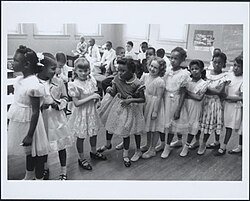BLACK SOCIAL HISTORY
Brown v. Board of Education, 1954
In the spring of 1951, black students in Virginia protested their unequal status in the state's segregated educational system. Students at Moton High School protested the overcrowded conditions and failing facility.[18] Some local leaders of the NAACP had tried to persuade the students to back down from their protest against the Jim Crow laws of school segregation. When the students did not budge, the NAACP joined their battle against school segregation. The NAACP proceeded with five cases challenging the school systems; these were later combined under what is known today as Brown v. Board of Education.[18]
On May 17, 1954, the U.S. Supreme Court handed down its decision regarding the case called Brown v. Board of Education of Topeka, Kansas, in which the plaintiffs charged that the education of black children in separate public schools from their white counterparts was unconstitutional. The Court stated that the
The lawyers from the NAACP had to gather some plausible evidence in order to win the case of Brown vs. Board of Education. Their way of addressing the issue of school segregation was to enumerate several arguments. One of them pertained to having an exposure to interracial contact in a school environment. It was said that it would, in turn, help to prevent children to live with the pressures that society exerts in regards to race. Therefore, having a better chance of living in democracy. In addition, another was in reference to the emphasis of how "'education' comprehends the entire process of developing and training the mental, physical and moral powers and capabilities of human beings".[19]
Risa Goluboff wrote that the NAACP's intention was to show the Court's that African American children were the victims of school segregation and their futures were at risk. The Court ruled that both Plessy v. Ferguson (1896), which had established the "separate but equal" standard in general, and Cumming v. Richmond County Board of Education(1899), which had applied that standard to schools, were unconstitutional.
The federal government filed a friend of the court brief in the case urging the judges to consider the effect that segregation had on America's image in the Cold War. Secretary of State Dean Acheson was quoted in the brief stating that "The United States is under constant attack in the foreign press, over the foreign radio, and in such international bodies as the United Nations because of various practices of discrimination in this country." [20][21]
The following year, in the case known as Brown II, the Court ordered segregation to be phased out over time, "with all deliberate speed".[22] Brown v. Board of Education of Topeka, Kansas (1954) did not overturn Plessy v. Ferguson (1896). Plessy v. Ferguson was segregation in transportation modes. Brown v. Board of Education dealt with segregation in education. Brown v. Board of Education did set in motion the future overturning of 'separate but equal'.
On May 18, 1954 Greensboro, North Carolina became the first city in the South to publicly announce that it would abide by the Supreme Court's Brown v. Board of Educationruling. "It is unthinkable,' remarked School Board Superintendent Benjamin Smith, 'that we will try to [override] the laws of the United States."[23] This positive reception for Brown, together with the appointment of African American Dr. David Jones to the school board in 1953, convinced numerous white and black citizens that Greensboro was heading in a progressive direction. Integration in Greensboro occurred rather peacefully compared to the process in Southern states such as Alabama, Arkansas, and Virginia where "massive resistance" was practiced by top officials and throughout the states. In Virginia, some counties closed their public schools rather than integrate, and many white Christian private schools were founded to accommodate students who used to go to public schools. Even in Greensboro, much local resistance to desegregation continued, and in 1969, the federal government found the city was not in compliance with the 1964 Civil Rights Act. Transition to a fully integrated school system did not begin until 1971.[23]
Many Northern cities also had de facto segregation policies, which resulted in a vast gulf in educational resources between black and white communities. In Harlem, New York for example, neither a single new school was built since the turn of the century, nor did a single nursery school exist – even as the Second Great Migration was causing overcrowding. Existing schools tended to be dilapidated and staffed with inexperienced teachers. Brown helped stimulate activism among New York City parents like Mae Mallorywho, with support of the NAACP, initiated a successful lawsuit against the city and state on Brown's principles. Mallory and thousands of other parents bolstered the pressure of the lawsuit with a school boycott in 1959. During the boycott, some of the first freedom schools of the period were established. The city responded to the campaign by permitting more open transfers to high-quality, historically-white schools. (New York's African-American community, and Northern desegregation activists generally, now found themselves contending with the problem of white flight, however.)[24][25]


























No comments:
Post a Comment